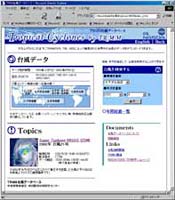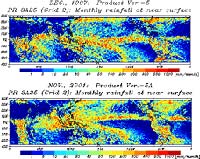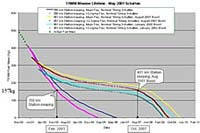Topics List
Jun. 22, 2015 Updated
TRMM ends its 17 years of observations
|
The Japan-U.S. joint satellite project, Tropical Rainfall Measuring Mission “TRMM” satellite, re-entered the atmosphere at 12:55 p.m. on June 16, 2015 (Japan Standard Time) over the South Indian Ocean. The TRMM satellite, launched by the H-II Launch Vehicle No. 6 on Nov. 28, 1997, far exceeded its design life of three years and two months and continued observations for 17 years to contribute to research on the study of precipitation.
TRMM achievements and heritage are succeeded by the GPM core observatory with the Dual-frequency Precipitation Radar (DPR) onboard. The DPR is the upgraded Precipitation Radar (PR) of the TRMM. |

|
|---|
Oct. 8, 2014 Updated
TRMM/PR completed the post-mission operation
|
The Precipitation Radar (PR) aboard the Tropical Rainfall Measuring Mission (TRMM) satellite completed its post-mission operation on October 7, 2014 (UTC.) The TRMM has been in its 17th year of operation, well exceeding its design life expectancy of three years and two months. |
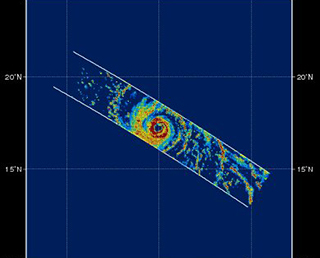
|
|---|
Dec. 3, 2012 Updated
Certificate of appreciation to Japan and US TRMM scientists from JAXA and NASA
|
Certificate of appreciation was given to eight Japan and US TRMM scientists for their outstanding contribution to the scientific activities, applications and accomplishments of 15 successful years of the TRMM, from Dr. Masanori Homma, Executive Director, JAXA, and Dr. Michael Freilich, Director, Earth Science Division, NASA. |

|
|---|
Sep. 20, 2012 Updated
The 15th Anniversary of the TRMM - Water for Life: Symposium on the role of space data-
|
To celebrate the Tropical Rainfall Measuring Mission (TRMM) satellite's 15th anniversary on November 28, we will held the public symposium on November 12 in Tokyo?Japan. TRMM's achievements and contributions to the society will be summarized and introduced at the symposium. Date: 12 November, 2012, (Monday), 10:00-17:00
Venue: Otemachi Sankei Plaza, Hall(4F), Tokyo, Japan Registration: Pre-registration needed. Free of charge Language: Japanese and English. Simultaneous interpretation is available. |
 |
|---|
Aug. 13, 2012 Updated
The 7th Precipitation Measuring Mission (PMM) Science Research Announcement
|
In this seventh Precipitation Measuring Mission (PMM) Science Research Announcement (RA), the Japan Aerospace Exploration Agency (JAXA) announces the opportunity for researches, relating to the Global Precipitation Measurement (GPM) mission and the Tropical Rainfall Measuring Mission (TRMM) satellite. |
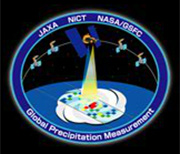 |
|---|
Aug. 10, 2009 Updated
6th Precipitation Measuring Mission (PMM) Science Research Announcement
|
In this sixth Precipitation Measuring Mission (PMM) Science Research Announcement (RA), the JAXA announces the opportunity for researches, relating to the Global Precipitation Measurement (GPM) mission and the Tropical Rainfall Measuring Mission (TRMM) satellite. |
 |
|---|
Apr. 23, 2009 Updated
TRMM ranks third in NASA's ten best earth observation achievements
-- Online Poll Ranks NASA's Biggest Hits for Planet Earth --
|
NASA carried out an online poll for the biggest hits for planet Earth, and anybody could vote through the Internet for one of the 10 best accomplishments for Earth observations. Observation achievements by the Tropical Rainfall Measuring Mission "TRMM," in which a sensor developed by JAXA is installed, was one of the listed accomplishment entitled "From Storm-Spotting to Next Week's Weather." On Earth Day on April 22, the results of the poll were announced, and that accomplishment, including TRMM's observation of hurricanes and tropical depressions, was ranked third. |
 |
|---|
Nov. 14, 2007 Updated
"Global Rainfall Map in Near Real Time" site is open
|
The Earth Observation Research Center (EORC) of JAXA has started to release image data of a high-resolution global precipitation distribution map in quasi real time (about four hours after observations) on the Internet. The map is composed by the EORC using acquired data by earth observation satellites including the Tropical Rainfall Measuring Mission (TRMM.) |
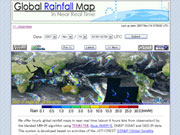 |
|---|
Oct. 12, 2005 Updated
NASA DECISION ON TRMM EXTENSION
|
On September 28, 2005 NASA officially approved the extension of TRMM science operations through fiscal year 2009 (September 30, 2009). Further extension may be considered at the end of that period. |
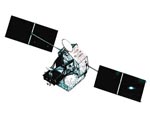 |
|---|
Aug. 6, 2004 Updated
TRMM operation extended
|
The operation of the Tropical Rainfall Measuring Mission (TRMM) has been extended at the request of the National Oceanic and Atmospheric Administration (NOAA). TRMM will continue its operation until the end of 2004 to cover this Summer's typhoon season. |
|
|---|
Jul. 9, 2004 Updated
Operation Completion of TRMM
|
The Tropical Rainfall Measuring Mission (TRMM), which was launched in 1997, has provided a huge amount of useful observation data on the atmosphere-hydrosphere and on the earth's water circulation for much longer than its original scheduled mission life of three years. The TRMM satellite has been a very successful mission, both operationally and academically, however, its operation will be terminated soon. |
|
|---|
Oct. 31, 2002 Updated
|
The Tropical Rainfall Measuring Mission (TRMM) satellite, which was launched at the end of November 1997, will soon mark its 5th anniversary. The National Space Development Agency of Japan (NASDA), Osaka Prefecture University, Communications Research Laboratory (CRL) and the National Aeronautics and Space Administration (NASA) will hold an international symposium commemorating the 5th anniversary of the launch of the TRMM satellite. It is entitled "Earth Observation from Space - Centering Water Cycle", and will be held on November 14, 2002 at Osaka Prefecture University, Academic Exchange Hall, in Sakai-shi, Osaka. In this symposium, the scientific achievements of TRMM, and its successor, Global Precipitation Measurement (GPM) mission, will be presented by several speakers to those interested in global environment issues, including researchers from industrial, government and educational areas, students and common folks. |
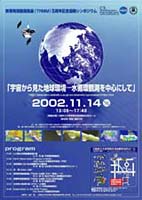 |
|---|
Oct. 7, 2002 Updated
|
On October 3, NASDA's Earth Observation Research Center (EORC) released a database of typhoons (including hurricanes and cyclones) observed by the Tropical Rainfall Measuring Mission (TRMM) satellite on the TRMM web site as the "TRMM Tropical Cyclone Database." |
Apr. 30, 2002 Updated
|
The Global Precipitation Measurement (GPM) concept was based on TRMM`s achievements, and this concept is currently being studied. The GPM satellites consist of a TRMM-type primary satellite that carries a radar and a microwave radiometer and a fleet of constellation satellites that carry microwave radiometers. The primary satellite plans to go to higher latitudes than TRMM to extend the coverage. The constellation satellites will measure precipitation frequently and globally. GPM is currently planned to start operating in 2007-2008 timeframe. The primary satellite is planned to carry a Dual-frequency Precipitation Radar (DPR) and a microwave radiometer. The combination of these two instruments will improve the accuracy of rainfall measurement and also realize snowfall observation, especially at higher latitudes. The 2nd GPM International Planning Workshop will be held from 20th (Mon.) through 22nd (Wed.) May 2002 at the Shinagawa Prince Hotel in Tokyo. The National Space Development Agency of Japan (NASDA), the Communications Research Laboratory (CRL) and the U.S. National Aeronautics and Space Administration (NASA) will co-host this workshop. Please see more details here. |
Dec. 25, 2001 Updated
|
The Tropical Rainfall Measuring Mission (TRMM) satellite completed four years in orbit on November 28, 2001. In addition, TRMM's orbit was successfully raised in August 2001, significantly extending its mission operation period. |
Sep. 21, 2001 Updated
|
TRMM completed its nominal three year mission in January 2001, and is continuing to operate. Based NASA's latest mission analysis, TRMM's lifetime will be shorter than the previous estimate. Figure shows NASA's latest estimate of the TRMM mission lifetime. The end of mission lifetime, when fuel will decrease to the maximum weight of 157 kg needed for controlled reentry, will be March 2003 if TRMM continues operating at the current 350 km height, and October 2007 if TRMM's orbit is raised to an altitude of 400 km. |
